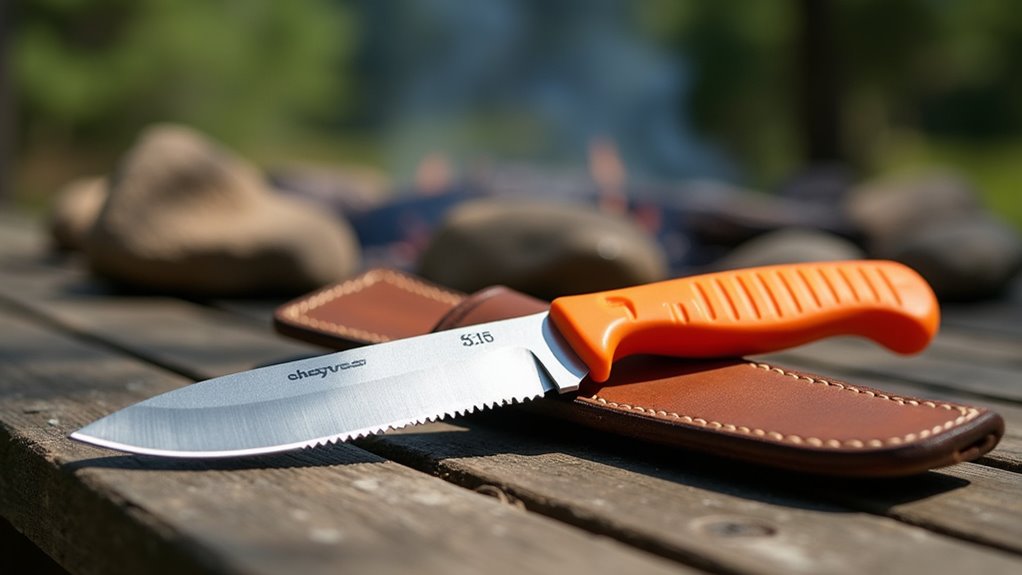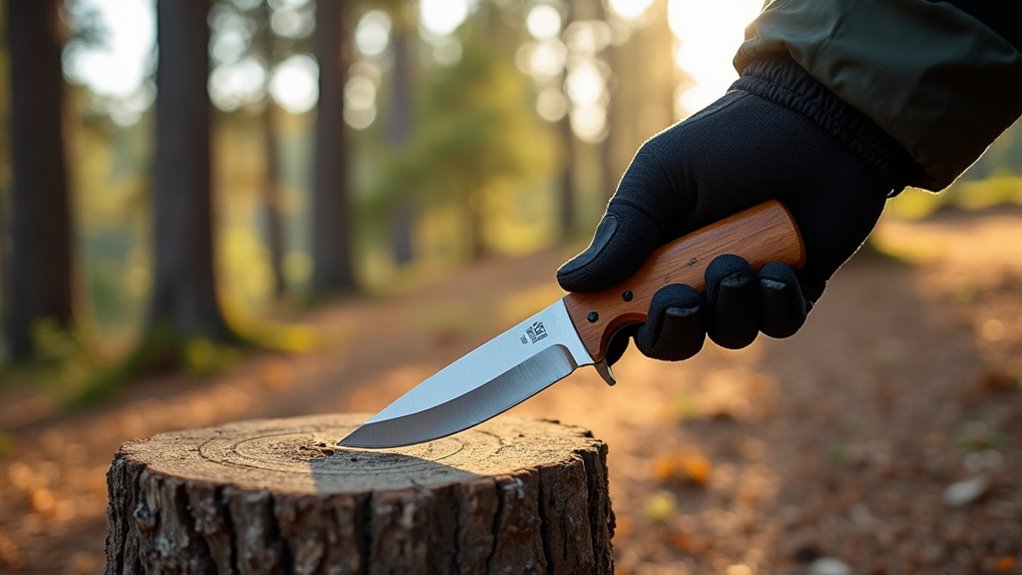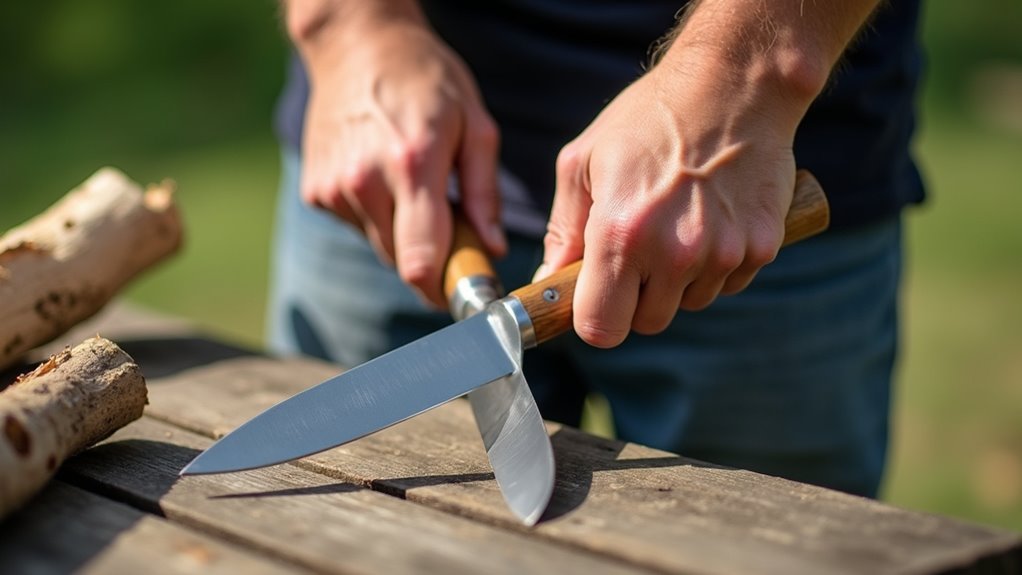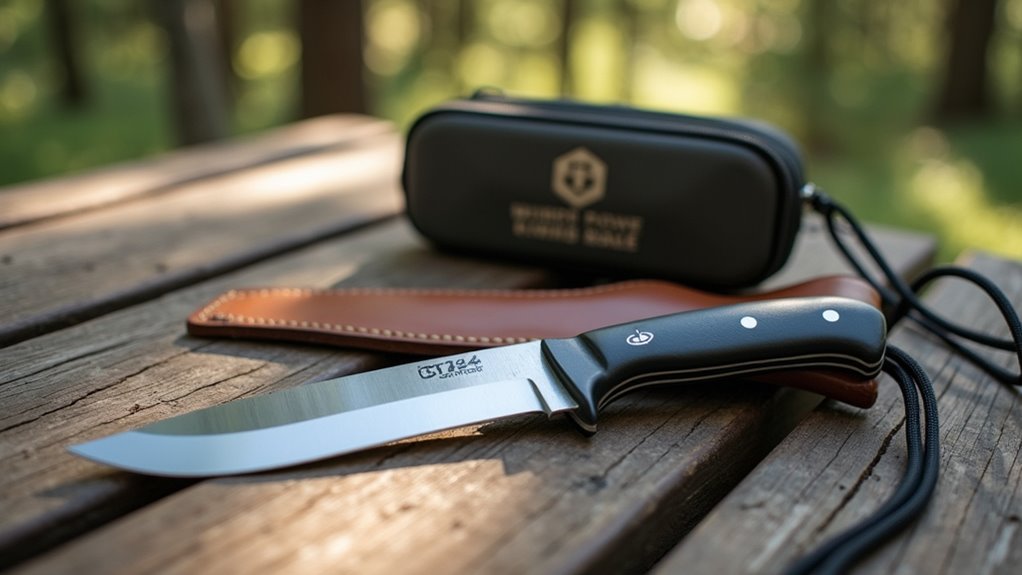Physical Address
304 North Cardinal St.
Dorchester Center, MA 02124
Physical Address
304 North Cardinal St.
Dorchester Center, MA 02124

Why risk your outdoor adventure with improper knife handling when these essential safety tips could prevent dangerous mistakes?
When you’re out in the wilderness, your camping knife can be your best friend or your worst enemy – it all depends on how you handle it. You’ll find that proper knife safety isn’t just about protecting yourself; it’s about ensuring everyone at your campsite stays safe too. While the basic rules might seem obvious, even experienced campers can make dangerous mistakes. Let’s explore the essential guidelines that’ll keep your outdoor adventures incident-free and enjoyable.

When camping in the wilderness, following proper knife safety rules can prevent serious injuries and potentially life-threatening situations.
Always cut away from your body using controlled, deliberate strokes, and stay seated while carving to maintain stability. Keep your focus on the task – don’t look away or let distractions compromise your safety.
Maintain a “blood bubble” by ensuring no one’s within arm’s reach while you’re using your knife. Work in well-lit areas and keep your workspace clear of obstacles.
Don’t use your knife for prying or twisting, as this can break the blade and cause injury. When passing a knife to someone else, hand it handle-first. After using your knife, store in its sheath immediately to prevent accidents.
Keep your blade sharp and clean – a dull knife requires more force and is more likely to slip, increasing accident risks. Familiarize yourself with essential camping gear before your trip to ensure you have the necessary items for a safe and comfortable experience.
Selecting the right camping knife requires careful consideration of your specific outdoor activities and budget.
If you’re primarily cooking at camp, look for a camping chef knife like the Off-Grid Viper V2. For wilderness survival tasks, you’ll want a bushcraft knife such as the Maxsa Blade with its versatile 6.5-inch blade and durable G10 handle. Experts recommend choosing a blade with at least 3/16-inch thickness for survival situations.
The essential benefits of a camping knife include versatility for a variety of outdoor tasks.
Consider blade materials carefully. CPM S35VN and Magnacut steel offer excellent durability but cost more, while AUS-10 steel provides good value with decent hardness.
If you’re backpacking, a folding knife like the Civivi Sendy will save weight. For general camping, a fixed blade knife offers reliability.
Look for features that match your needs: a sharp spine for fire starting, a guthook for lifting pots, or a Kydex sheath for secure carry.

Safe knife handling requires mastering proper grip techniques and cutting fundamentals. When using your camping knife, maintain a firm hammer grip with your thumb resting on the spine for stability, but don’t overgrip as this can lead to fatigue and accidents.
Always cut away from your body using smooth, controlled motions. Work on a stable surface in a well-lit area, and let the object you’re cutting move rather than the knife. Essential safety gear should be used while camping to ensure your safety. Keep your blood circle clear by ensuring others stay at a safe distance while you’re working.
Cut with steady control, away from yourself. Work on stable surfaces and keep others outside your safety zone.
Stay focused when handling your knife – avoid using it when you’re tired or distracted. Keep your blade sharp, as dull knives require more force and increase accident risk. Immediately store in sheath after completing your task to prevent accidental cuts.
Maintain awareness of the triangle of death area between your hips and knees while cutting.
Proper storage and transportation of your camping knife are just as important as safe handling techniques. Always use a knife sheath to protect the blade and prevent injuries during transport. You should aim to secure it to your belt or pack using dedicated straps or clips – never let it float loose in your gear. A light coat of moisture-resistant oil can significantly extend your knife’s lifespan.
Keep your knife clean and completely dry before storage to prevent rust and corrosion. Proper knife maintenance is crucial for ensuring the longevity of your camping tool. Store it separately from food items and other gear to maintain hygiene and avoid dulling the blade.
Choose a cool, shaded storage spot away from heat sources and direct sunlight to protect both the blade and handle.
Don’t forget to use childproof storage if needed, and always transport your knife in its sheath. This simple practice prevents accidents and keeps your blade in prime condition.

While camping adventures can be unpredictable, having a well-thought-out emergency prevention plan is essential for knife safety.
With over 8 million knife-related injuries reported in U.S. emergency departments, it’s vital to prioritize both prevention and response strategies during your outdoor activities.
Make sure you’re prepared by incorporating these essential safety measures:
Understanding that multi-functionality increases utility through tools like pocket knives means you can accomplish more tasks safely with proper training and awareness.
Teaching knife safety to others requires a structured and deliberate approach, since inexperience accounts for many camping-related accidents.
Start by demonstrating proper grip techniques and establishing clear safety zones, emphasizing the “blood bubble” concept that keeps others at arm’s length plus knife length away.
Show them how to select the right knife for specific tasks and stress that sharp blades are actually safer than dull ones. Early supervised practice creates competent adult knife users. Essential camping gear should also be considered when teaching knife safety.
Make sure they understand to always cut away from their body and to stay seated while using the knife. You should aim to reinforce that knives are tools, not toys, and should never be used as substitutes for other implements.
When teaching groups, have them practice one at a time and encourage them to ask questions.
Don’t forget to demonstrate proper storage and handling procedures.
Your camping knife is your trusty sidekick in the wilderness, but like any powerful tool, it demands respect and caution. By following these safety guidelines, choosing the right knife, and mastering proper techniques, you’ll create a safer outdoor experience for everyone. Remember to store your blade properly, stay prepared for emergencies, and share your knowledge with fellow campers. Smart knife handling leads to worry-free adventures.